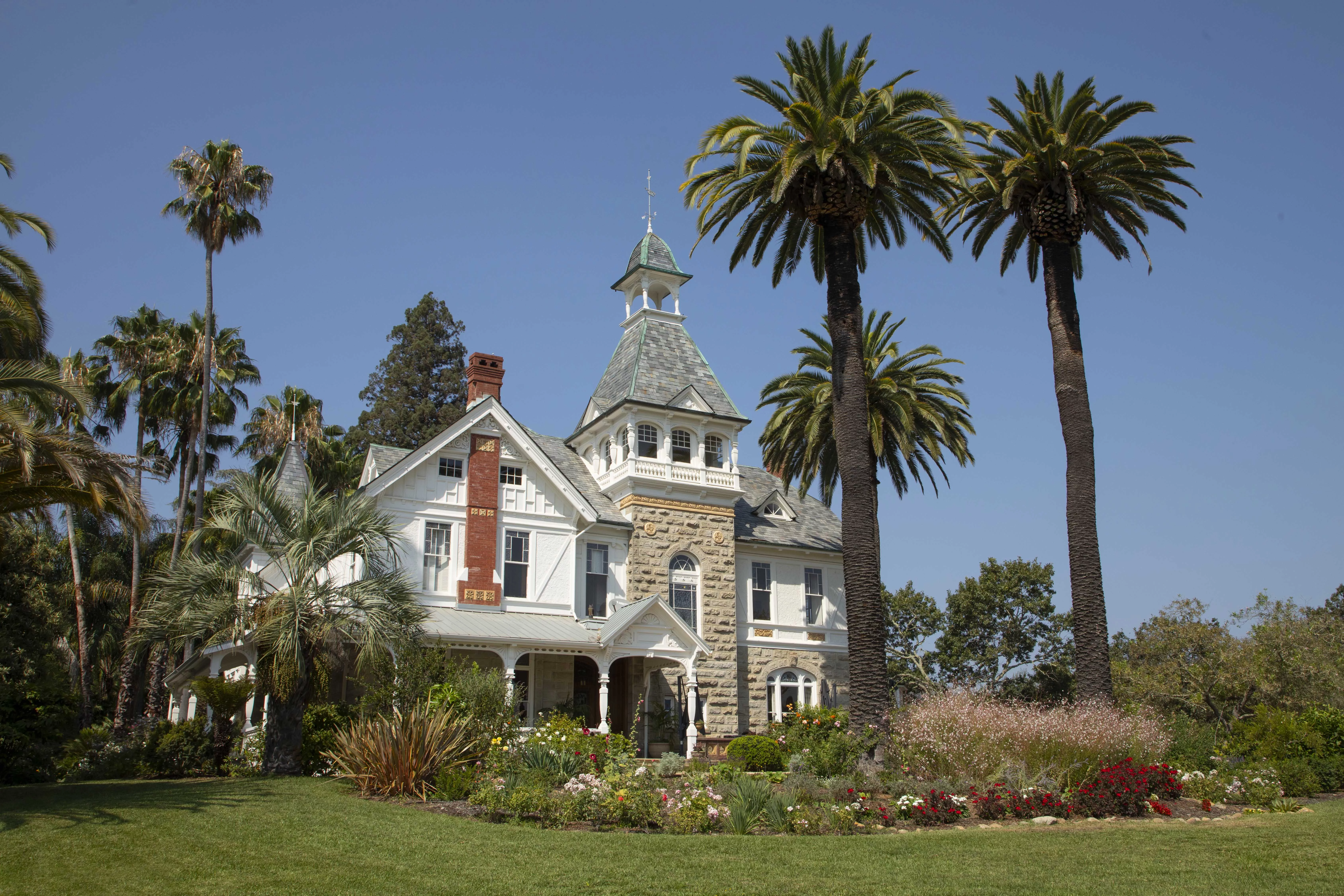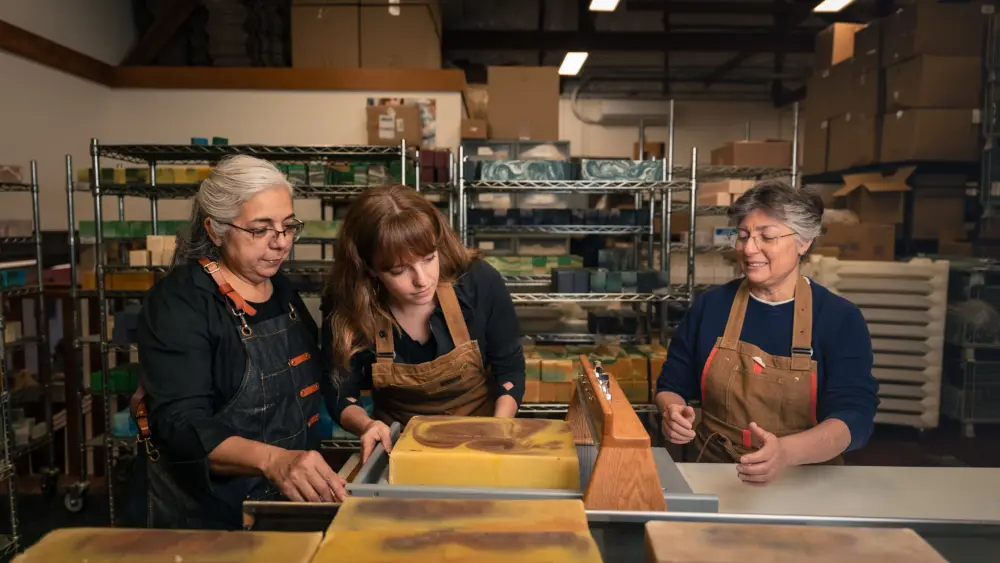A winery with a colorful past is set to return to its former days of glory.
In August, MGG Investment Group, a New York City-based financial institution, acquired the 845-acre Spring Mountain Vineyard in an auction bankruptcy proceeding. Under new management, the St. Helena winery is about to get a facelift.
There’s excitement in the air— and for good reason. Numerous renovations are planned for the historic site. Some of those include replanting of 200-plus acres of vineyard, a winery upgrade, renovation of the wine caves, a new water reservoir and a revamped hospitality center. The winery’s flagship Elivette Cabernet Sauvignon is already highly rated.
The mind boggles at what might be achieved with the proper investment and some TLC. The term most often used to describe the winery by those in the industry is “untapped potential.”
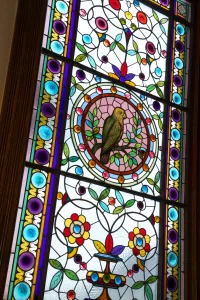
A colorful past
Founder Tiburcio Parrott was born in 1840 in Mazatlan, Mexico—the son of John Parrott, U.S. Consul in Mazatlan, and his mistress, Doloris, a Mazatlan native. Following his education in England and the U.S.—and after a brief stint working on Wall Street—the younger Parrott moved to San Francisco to work for his father who, following his Mazatlan post, had opened a successful bank. Following John Parrot’s death in 1884, stepmother Abby purchased 800 acres on Spring Mountain for Tiburcio. There he planted a vineyard, 5,000 olive trees, 1,000 citrus, and 5,000 European and American Beauty rose bushes. He built a small winery and tunneled a cave in the hillside for wine storage. As the focal point, he constructed an 8,000-square-foot Victorian mansion with wraparound verandahs, a conservatory and views of the valley. (His initial “P” remains inscribed in stained glass over the massive entry.) Within the mansion, a large stained-glass panel serves as backdrop for the main staircase. The center of the colorful panel portrays a parrot perched on a branch. Tiburcio named his vast estate Miravalle, meaning “look valley.”
As legend has it, Tiburcio would ride into town in his surrey to visit the hardware store, bank and post office. A bachelor for most of his life, he’d complete the trip with a stop at the Stone Bridge Bordello. A servant standing on a platform on the back of the carriage would blow an English hunting horn alerting the girls to his arrival.
He became good friends with brothers Frederick and Jacob Beringer, Napa Valley winemaking pioneers. In an ongoing, good-natured rivalry Tiburcio intentionally built his mansion 500 square feet larger than their famed Rhine House in St. Helena; he later married the Beringer’s maid. Following Tiburcio’s death from apparent stomach cancer in 1894, Miravalle sat virtually empty for 75 years.
The birth of Spring Mountain Vineyard
Developer Michael Robbins moved to Napa Valley in 1969 to pursue his winemaking passion. In 1974, after launching a small winery near Dear Park Road in St. Helena, he acquired the abandoned Miravalle estate—combining operations and changing the name to Spring Mountain Vineyard. He renovated the mansion and constructed a 17,000-square-foot winery adjacent to Tiburcio’s wine cave. His wines became highly regarded, winning many prestigious competitions. Spring Mountain’s chardonnay won honors at the famous 1976 Judgment of Paris, where for the first time California wines held their own against French wines in a blind tasting.
In the 1980s Spring Mountain Vineyard achieved fame of another kind—as the Miravalle mansion became the site for filming the hugely popular primetime TV soap opera Falcon Crest. For 227 episodes, broadcast from 1981 to 1990, the tough, tyrannical matriarch Angela Channing, played by Jane Wyman, held sway over the family’s Falcon Crest Winery set in the fictional Tuscany Valley. Though the show’s cultural impact has long since faded in the U.S., that’s not so in Europe. To this day, women in Spain who are being difficult are referred to as “an Angela.” Garrett Hales, estate director at Spring Mountain, says, “I often get calls from European visitors wanting to come see the Falcon Crest mansion.” They’ll be surprised to learn that the “falcon crest” in the stained-glass panel is actually a parrot.
In 1992 Jacob E. Safra—scion of the billionaire Safra banking family, owner of Encyclopedia Britannica and financer of eight Woody Allen movies—purchased the winery. He added neighboring vineyards Chevalier, Alba and La Perla in 1993 and 1996. The acquisitions resulted in an 847-acre parcel with 225-acres of hillside vineyards and 135 blocks with eight soil types at elevations ranging from 400 to 1,600 feet. It’s one of the most challenging, unique growing sites in the valley with microclimates perfect for grapes.
Safra had an unorthodox idea for promoting his wine—he closed the winery for public visitation for a decade, from 1993-2003. The strategy was to give the brand a head start by restricting direct-to-consumer sales, grow a wine library and demonstrate on reopening the wine’s superb aging characteristics. Spring Mountain Vineyard is currently one of Napa Valley’s largest wine libraries with vintages dating back to 1979.
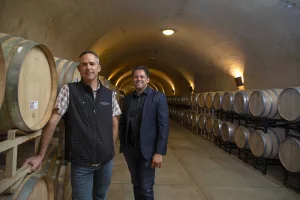
Over the years, Spring Mountain wines continued to receive high praise and recognition. In 2019 its sauvignon blanc was served at the White House state dinner for the visit of the Australian prime minister.
Though the wines were successful, the estate struggled financially. Then the devastating Glass and Boysen wildfires of 2020 roared through the property damaging the vineyards and destroying several historic buildings. (Miravalle was spared.) The onset of the pandemic in 2020 was more than the company could bear and in 2021 Safra defaulted on a $185 million term loan due to MGG Investment Group. A year later he filed for bankruptcy.
Enter MGG
MGG Investment Group acquired Spring Mountain Vineyard this past August at public auction with a credit bid of $43 million. Kevin Griffin, chief executive officer and chief investment officer with MGG, describes Spring Mountain Vineyard as “a bedrock Napa Valley institution.”
Griffin credits the “unique terroir” of Spring Mountain’s location for enabling it to produce “some of the finest wines in the world.”
“While we honor the winery’s past, we look forward to charting a new path forward by focusing on operational excellence and reinvigorating relationships with club members, visitors, distributors and the St. Helena community,” Griffin says.
Spring Mountain marks MGG’s first acquisition in the wine industry—though as lender to the winery over the past five years MGG is well familiar with its operations, and its potential.
MGG brought in wine industry veteran Peter Ekman as new CEO of Spring Mountain. His responsibilities include property oversight, wine production and commercial operations. Ekman has the skillset and experience for this kind of job—he bills himself as a turn-around specialist having worked in the wine, consumer goods and e-commerce industries. His career began with Procter & Gamble in Europe. That followed with a string of successes in the U.S. wine industry at Moët Hennessy, Cosentino wineries, Bulgheroni Estate, and Bounty Hunter Wine & Spirits. He helped build the business model for Vivino, one of the largest wine-purchasing apps in the world.
“Spring Mountain has a rich 150-year legacy,” Ekman says. “The property is breathtaking, the vineyards and wines exceptional. With enthusiastic, supportive new owners, greater resources and an experienced dedicated team, we are well positioned for success.”

Winemaker Barrett Anderson joined Spring Mountain Vineyard in 2019. He grew up in Geyserville, his father a doctor. Planning to follow in his father’s footsteps, he earned a degree in biology from UC Santa Barbara—but landing a job in a winery lab set him off in a new direction.
Drawn by the science of fermentation—as well as a love for the outdoors and the social aspects of the wine business—he continued working with wineries in Sonoma, Napa and Australia to learn winemaking skills. Eventually he earned a graduate degree in oenology and viticulture from the University of Adelaide in South Australia. Having spent several years at North Bay wineries, Anderson is well familiar with the challenges and rewards of growing grapes on rocky slopes. His eyes light up when he talks about all Spring Mountain Vineyard has to offer. “Being here is a winemaker’s dream,” he says. “The soils, the slopes and western exposure provide the perfect environment for growing grapes. I have the best grapes in all Napa to work with. I like working with the mountain’s smaller berries. I try to maintain their natural flavor and elegance with no manipulation in the cellar.”
Ron Rosenbrand is vineyard manager. After 20 years on the job, he perhaps knows the vineyards better than anyone. And he knows the Napa Valley wine industry—it’s in his genes. His father Theo was a renowned winemaker at Beaulieu and Sterling vineyards; his wines are prized by collectors. Theo always stressed the importance of the vineyard in making good wine. So with an eye toward vineyard management, Ron studied viticulture at UC Davis, graduating in 1981. Prior to joining Spring Mountain Vineyard, he managed vineyards for Charles Krug.
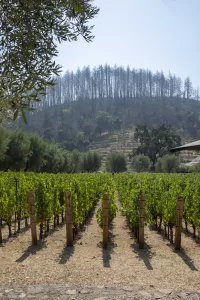
To round out the team, MGG retained the Napa Valley wine-consulting firm Atelier Melka. The firm specializes in working with small production, handcrafted, high-end wines. “We’re excited about our relationship with Spring Mountain Vineyard,” says Maayan Koschitzky, partner and director of winemaking. Koschitzky grew up working on his family’s farm in Israel. At school he studied engineering. Not looking forward to a life indoors huddled over a computer, Koschitzky was drawn to his agricultural roots—and to winemaking. Though wine may not be as closely associated with Israel as other renowned wine-making regions, the country has an impressive wine history—from biblical times to today’s $40 million wine-export market. The modern wine era of that region began in 1896, when Baron Edmond de Rothschild founded one of the country’s first wineries with vines from his famed Chateau LaFite in Bordeaux. Today there are over 20,000 acres of vineyards with a diverse range of grape varietals. The region, where grapes are grown in hot, dry arid conditions, is credited with introducing the drip irrigation system widely used in the wine industry today. Early in his career, Koschitzky worked for Israel’s Margalit Winery. The founder Yair Margalit became his mentor. “Margalit Winery produces some of the best red wine in the country,” Koschitzky says. “It was the perfect training ground.”
Wanting to experience winemaking in the Napa Valley and further his wine education at UC Davis, he contacted several wineries seeking an internship. One of those was Screaming Eagle, the winery where wine sells for more than $2,500 a bottle and there’s a 15-year wait list for wine club membership. “When I applied I wasn’t aware of their cult status,” he says. He landed the job and worked at Screaming Eagle for three years learning to make distinctive, exceptional wines. The plan was to return to Israel—that is, until he met Philippe Melka.
The founder of Atelier Melka has over 30 years of experience in the wine industry in Bourdeaux and Napa. The pair hit it off and Koschitzky joined the consulting firm in 2014. In addition to consulting, Koschitzky partnered with Silverado Farming Company to make his own wines under the label La Pelle. In English la pelle means shovel, the basic tool used in agriculture for digging into the soil and planting vines. Koschitzky’s winery produces cabernet sauvignon, chardonnay, sauvignon blanc and syrah. Grapes are sourced from Napa Valley and the renowned Bien Nacido vineyard in Santa Maria Valley on California’s central coast. “Spring Mountain Vineyard has the potential to be one of the top wineries in the valley,” Koschitzky says. “We look forward to helping make that happen.”
Atelier Melka is already involved in working with the winery on the development of a business plan and the 2023 red blend production.
Restoration and expansion
New investment will go toward implementation of several projects. A priority is the replanting of the 225-acre vineyard. Damage to the vineyards from the 2020 Glass Fire cannot be understated. Some of the impact can still be seen in the vineyard on the hill behind the old carriage house—the raging wildfire left large gaps in the rows where vines used to grow. “Vineyard restoration has already begun and that will continue over the next three years,” Ekman says. “Actually, there’s already been quite a bit of restoration work done which MGG financed [prior to the purchase]. They didn’t want the property to digress any further, so they did what they could to help.” And expansion of the vineyards is anticipated with the planting of an additional 90-acres subject to Napa County approval. The winery’s equipment—tanks, bottling line, etc., much of it dating back to the 1990s—will be updated. Winery production is averaging 5,000 cases a year—well below potential. (The vineyard replanting and expansion, and a winery upgrade should help with that, Ekman and his team believe.)
During the rainy season, water seeps into the cave Tiburcio tunneled 130 years ago. That portion of the caves will be renovated along with the larger section. In another fire casualty, the lining of the reservoir in the La Perla vineyard disintegrated in the heat—and that important water source will be replaced.
Under previous ownership, the winery kept a low public profile. That’s about to change, says Ekman. “We will be placing more emphasis on our direct-to-consumer marketing,” he says.
Bringing any business out of bankruptcy can be a challenge. Fortunately, Spring Mountain Vineyard is positioning to meet those challenges—with an injection of new capital, highly regarded wines, a breathtaking historic setting, an experienced team and the perfect terroir for growing grapes. Untapped potential, indeed.
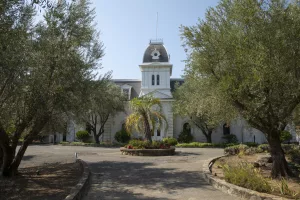
Tastings are offered in the Miravalle mansion from 10 a.m. to 3:30 p.m. daily. Appointments can be made online at springmountainwinery.com or by calling 707-967-4186.



